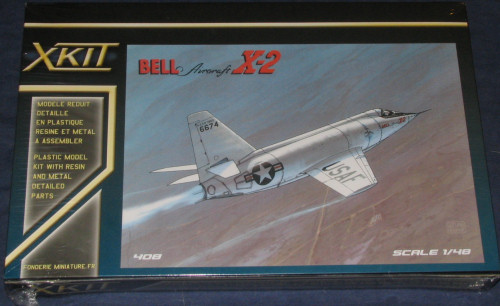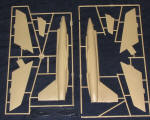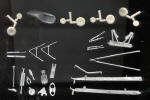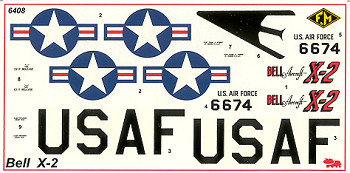
| KIT: | Fonderie Miniature 1/48 Bell X-2 |
| KIT #: | 408 |
| PRICE: | $65.95 MSRP |
| DECALS: | One options |
| REVIEWER: | Scott Van Aken |
| NOTES: | Multimedia kit with resin, etched and cast metal parts |

| HISTORY |
The Bell X-2 was a rocket-powered, swept-wing research aircraft designed to investigate the structural effects of aerodynamic heating as well as stability and control effectiveness at high speeds and altitudes. The program was developed jointly in 1945 by Bell Aircraft Corporation, the U.S. Air Force and the National Advisory Committee for Aeronautics (NACA) to explore aerodynamic problems of supersonic flight and to expand the speed and altitude regimes obtained with the earlier X-1 series of research aircraft.
In 1946, the NACA Pilotless Aircraft Research Division (PARD) began testing rocket launched X-2 models at Wallops Island, Va., to gather stability and control data. Additional tests helped NACA and Bell engineers design a pilot escape system for the X-2. The NACA made its spin tunnel and supersonic wind-tunnels at the Langley Memorial Aeronautical Laboratory, Hampton, Va., available to evaluate various aspects of the X-2 design. The NACA was also responsible for scientific instrumentation of the X-2.
Two X-2 airframes, nicknamed "Starbuster," were built at Bell's plant in Wheatfield, N.Y., using stainless steel and K-monel (a copper-nickel alloy). The vehicles were designed to employ a two-chamber Curtiss-Wright XLR25 throttleable liquid-fueled rocket engine. It had a variable thrust rating from 2,500 to 15,000 pounds. The X-2 was equipped with an escape capsule for the pilot. In an emergency, the entire nose assembly would jettison and deploy a stabilizing parachute. Once at a safe altitude, the pilot would then manually open the canopy and bail out. Although the Air Force approved the final escape system design, NACA representatives were concerned that it might prove dangerous to use.
A Boeing B-50A bomber was modified to carry the X-2 to launch altitudes around 30,000 feet. The pilot then climbed into the X-2, dropped away from the bomber, and ignited the engines if it was a planned powered flight. After engine burnout, the pilot guided the X-2 to an unpowered landing on the surface of Rogers Dry Lake at Edwards Air Force Base, Calif.
Because of a decision to install the first available engine in airframe 46-674, airframe 46-675 was delivered to Edwards first for glide tests. It arrived at Edwards on April 22, 1952. After two captive flights, Bell test pilot Jean L. "Skip" Ziegler made the first glide flight on June 27. A rough landing caused some damage to the aircraft and the second glide flight was delayed until Oct. 8. Two days later, Air Force test pilot Maj. Frank K. "Pete" Everest successfully completed the third glide flight of the X-2.
Following the unpowered tests, the X-2 was returned to Bell's plant in New York. The engine had not yet been installed in the first X-2, 46-674, so it was installed in the second shortly after it returned to Wheatfield. Captive flights with the new engine were carried out over Lake Ontario. During a flight to check the liquid oxygen system, an explosion resulted in the loss of the X-2 and severe damage to the B-50. Skip Ziegler and B-50 crew member Frank Wolko were both killed. The X-2 fell into Lake Ontario and was not recovered. The B-50A was damaged beyond economic repair and was subsequently replaced with a modified B-50D.
X-2 number one was finally ready for its flight from Wheatfield, N.Y. The following day, it began its journey to Edwards beneath the B-50D. The aircraft arrived on July 15 and technicians at the NACA High Speed Flight Station (HSFS) began to install instrumentation to gather handling qualities data. On the advice on the NACA, the Air Force purchased a Goodyear Electronic Digital Analyzer (GEDA) analog computer. Richard E. Day, NACA project engineer for the X-2, programmed the GEDA and turned it into a rudimentary flight simulator for the aircraft.
On Aug. 5, 1954, the X-2 was carried aloft for another captive flight beneath the B-50. Later that day, the X-2 was carried aloft for a second time and released. Pete Everest, now a lieutenant colonel, made a successful glide flight that ended in a rough landing on the lakebed. The vehicle sustained minor damage and was returned to Wheatfield for repair.
The X-2 returned to Edwards on Jan. 16, 1955, and captive flights resumed on Feb. 5 for propellant system checks. After several captive missions, two more glide flights were accomplished in March and April. Damage to the aircraft during landing required the X-2 to return to New York once again.
The first attempt at a powered flight took place on Oct. 25, 1955, but a nitrogen leak resulted in a decision to change the flight plan. Everest completed the mission as a glide flight. An aborted second attempt ended as a captive flight. Everest finally made the first powered X-2 flight on Nov. 18, igniting only the 5,000-pound-thrust chamber. His maximum speed during the mission was Mach 0.95. Following several aborted attempts, Everest completed a second powered flight on March 24, 1956, this time only igniting the 10,000-pound-thrust rocket chamber.
Both chambers were used for the first supersonic X-2 flight on April 25. The airplane reached a speed of Mach 1.40 and a maximum altitude of 50,000 feet. Everest completed three flights in May that pushed the airplane's speed envelope to Mach 2.53. On May 25, 1956, a new pilot was checked out in the X-2, Capt. Iven C. Kincheloe. He made a successful supersonic flight, but had to shut the engine down prematurely due to a malfunction. In June, the airplane was grounded for installation of engine nozzle extensions to improve performance. Everest made a supersonic checkout of the modified X-2 on July 12. Everest's final X-2 flight, on July 23, 1956, earned him the title "Fastest Man Alive." While gathering data on aerodynamic heating, Everest achieved a speed of Mach 2.87 at 68,000 feet.
Kincheloe now assumed the role of X-2 project pilot for a series of high-altitude missions. After two aborted flight attempts, he successfully accomplished a climb to 87,750 feet while gathering stability data on Aug. 3, 1956. That same day, NACA director Hugh L. Dryden requested that the Air Force loan the X-2 to the NACA for research purposes. The Air Force continued to fly the airplane while attempting to achieve its maximum altitude capability. While a flight on Aug. 8, failed to exceed 70,000 feet, another attempt on Sept. 7 reached an altitude of 126,200 feet. This earned Kincheloe the title "First of the Spacemen" and a record that stood until the advent of the X-15 program. Kincheloe made three additional flight attempts, but each ended in an abort.
The Air Force was due to transfer the X-2 to the NACA in mid-September and preparations were underway. Researchers at the NACA High Speed Flight Station were anxious to use the X-2 for heating investigations in the Mach 2 to Mach 3 range and study handling characteristics at extreme altitudes and speeds. The Air Force, however, asked for an extension of their program so that another pilot could be checked out. As Capt. Milburn G. "Mel" Apt practiced simulated missions on the GEDA, representatives from the Air Force, the NACA, and Bell agreed on a flight plan.
On Sept. 27, 1956, Apt became the first person to fly faster than three times the speed of sound. The engine burned slightly longer than expected and Apt flew a near perfect flight profile, allowing him to reach a speed of 2,094 mph (Mach 3.196). Elation was short lived. For some reason, Apt initiated a sharp turn back toward Edwards. This resulted in a control divergence known as inertial coupling. The X-2 began to tumble uncontrollably. Apt jettisoned the escape capsule, but was unable to extract himself before it struck the ground. Apt's death cast a shadow over the most spectacular achievement of the program.
| THE KIT |
 Fonderie
Miniature has been producing kits for a number of year. All of them have been
subjects that have drawn interest from modelers, though some of them are those
that would appeal more to the French modeler than to those outside the
Continent. This latest release is one that is of great interest to me as I've
always felt that the X-2 is one of the most aesthetically pleasing aircraft ever
built. It just oozes 'fast' even when sitting on the ground. It was also the
star in one of my top five favorite movies of all time, "Toward the Unknown",
which is one of those films that I can basically mouth the words as the movie
goes along I've watched it so many times.
Fonderie
Miniature has been producing kits for a number of year. All of them have been
subjects that have drawn interest from modelers, though some of them are those
that would appeal more to the French modeler than to those outside the
Continent. This latest release is one that is of great interest to me as I've
always felt that the X-2 is one of the most aesthetically pleasing aircraft ever
built. It just oozes 'fast' even when sitting on the ground. It was also the
star in one of my top five favorite movies of all time, "Toward the Unknown",
which is one of those films that I can basically mouth the words as the movie
goes along I've watched it so many times.
I have also built a F.M. kit or two in my life and have been amazed that little has improved between the earlier kits and the newer ones. I can only hope that this one has shown some improvement as there are modelers who have been unable to finish a kit or two of theirs due to some major construction problems.
This one certainly has little in the way of injected plastic bits with that medium being used only for the basic airframe; basically 8 pieces. The plastic is basically smooth, but with some striations in the plastic. One may want to lightly sand all the surfaces to remove these. The engraved panel lines are of a good size and they are also somewhat rough so a gently rescribe of some areas would be prudent. I found a few sink areas near the wing tips.
 One small bag holds the wheel halves and the resin
cockpit. These wheels are for the support cradle as the aircraft's lone nose
wheel is cast in metal. In fact, the majority of detail bits are in cast metal
and this includes the support cradle, wing and fuselage skids, nose gear, nose
probe and all the interior bits. These are all very nicely cast and though they
will need cleaned of the mold seams, this is quite small and should be quickly
accomplished. Both extended and retracted skids are provided so you can either
display the aircraft on the ground or on the support cradle. The aft nozzle section is but a plate with two holes in it so one
will have to come up with something to prevent visitors from peering into the
empty fuselage. The various dump tubes will also have to be manufactured by the
builder as the kit provided nothing for them.
One small bag holds the wheel halves and the resin
cockpit. These wheels are for the support cradle as the aircraft's lone nose
wheel is cast in metal. In fact, the majority of detail bits are in cast metal
and this includes the support cradle, wing and fuselage skids, nose gear, nose
probe and all the interior bits. These are all very nicely cast and though they
will need cleaned of the mold seams, this is quite small and should be quickly
accomplished. Both extended and retracted skids are provided so you can either
display the aircraft on the ground or on the support cradle. The aft nozzle section is but a plate with two holes in it so one
will have to come up with something to prevent visitors from peering into the
empty fuselage. The various dump tubes will also have to be manufactured by the
builder as the kit provided nothing for them.
Two vacuformed canopy sections are supplied. The canopy on this aircraft was bolted in place so one needs to decide if one wants to put any major effort into interior detailing. These canopies can only be described as fair as they are not super transparent and are not crisply detailed, though the plastic is properly thick, making attachment that much easier.
 The
instructions are two double side printed sheets of paper. Due to the paucity of
parts in aircraft like this, the drawings are more than sufficient to be able to
properly place all the various bits. There are construction steps and written
instructions as to what order to assemble the bits. No painting information is
supplied, but photos of this aircraft are easy enough to find for doing detail
bits. The decal sheet is well printed and glossy, providing markings for the
first aircraft. A nose anti-glare panel is included, a nice touch. The insignia
proportions seem a bit odd so I'd check photos prior to using them. I don't
recall any problems using FM's decals in the past so these should work quite
well.
The
instructions are two double side printed sheets of paper. Due to the paucity of
parts in aircraft like this, the drawings are more than sufficient to be able to
properly place all the various bits. There are construction steps and written
instructions as to what order to assemble the bits. No painting information is
supplied, but photos of this aircraft are easy enough to find for doing detail
bits. The decal sheet is well printed and glossy, providing markings for the
first aircraft. A nose anti-glare panel is included, a nice touch. The insignia
proportions seem a bit odd so I'd check photos prior to using them. I don't
recall any problems using FM's decals in the past so these should work quite
well.
| CONCLUSIONS |
This is yet another case of subject overcoming what could be common sense in picking up a kit that I know will not be an easy build. I'd be delighted to be proven wrong, especially as I've wanted a larger scale X-2 for a long time and this one shows a lot of promise. I'm very much looking forward to building it in the future.
March 2006
| REFERENCES |
Your tax money at work as I swiped the whole historical background from http://www.nasa.gov/centers/dryden/home/index.html
If you would like your product reviewed fairly and quickly by a site that has over 300,000 visitors a month, please contact me or see other details in the Note to Contributors.